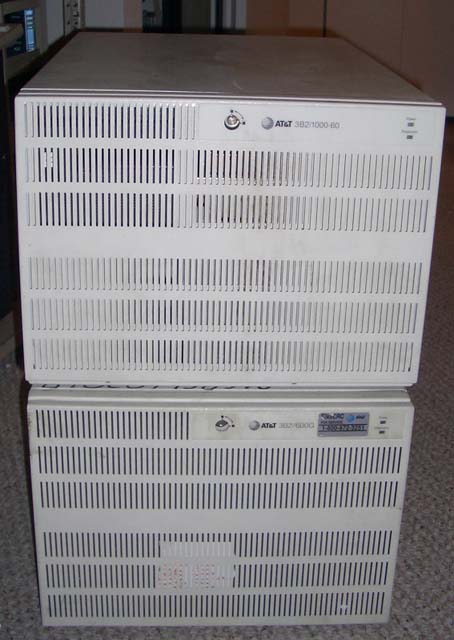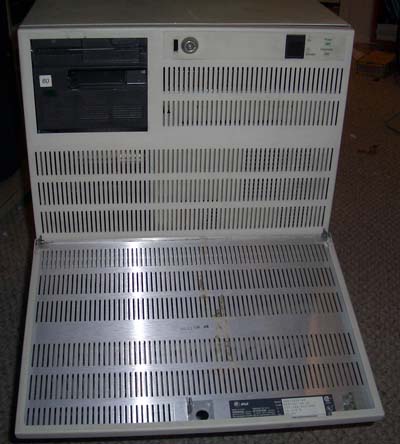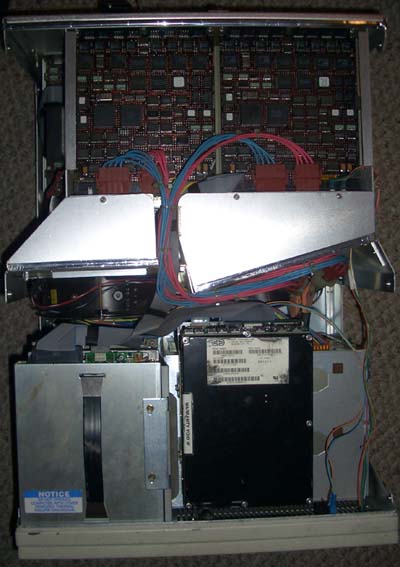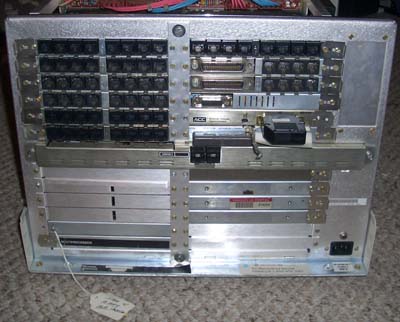
AT&T 3B2 1000/60(and 80)

Specifications
Comments
The AT&T 3B2 1000/60 was my first real exposure to a UNIX machine and as such it holds a special place in my heart. In 1995 my friend John acquired this machine from another friend (who I assume got it from some business that was throwing it out) along with a Qume dumb terminal, a 1200bps modem, and a few other assorted odds and ends. We both learned quite a bit about how UNIX worked by screwing around with it. At one point John even had this thing up and running as a BBS of sorts (named "retrobox") over the screaming fast modem.
When John went off to college, I inherited it at which point it immediately developed serious hard drive problems rendering it a very bulky doorstop. Having no source of backup media (as it soon turned out the 120MB tape drive was dead) it remained that way for quite awhile. Eventually, through the assistance of some kind souls on usenet I managed to coax UNIX System V 3.2.3 onto a replacement drive. It still runs today, though it's not particularly useful. I have yet to figure out a way to transfer over the limited software I've been able to find for it, so it doesn't do much.
I picked up the 1000/80 (also known as the 600G as pictured) off of eBay mostly because it came equipped with an Ethernet card which I'd been looking for for quite some time. I also figured that it wouldn't hurt to have some spare parts. As it turns out, the 600G came loaded with memory and multiprocessor boards, as well as a functional hard drive with System V 3.2.2 loaded on it. Not a bad haul.
Unfortunately I lack drivers and software for the Ethernet board, the Multiprocessor boards, and a few other random boards (the function of which I can only begin to speculate). If anyone out there in Internet land has a source for these drivers and software (preferably accompanying a means to actually get the software on the 3B2 as well) please, please, please drop me a line.
Pictures
 |
This is the front of the 1000/60 with the front panel opened up. At the upper left is the 5.25" floppy drive (720KB capacity) and just below that the 60MB Wangtek tape drive. At the upper right is the "soft" power switch -- much like modern PCs the power to the system was controlled by the system firmware and OS. The front of the 1000/80 is identical with the exception of a 120MB tape drive in place of the 60. |
 |
Here's a shot of the guts of the machine. The top of the picture is the rear of the machine where all the expansion cards live. The PCBs you see there are two EPORTS cards (described below). At the bottom is the front of the machine. The cage on the left has a handle on the top allowing "easy" access to the tape and floppy drives (in practice I never found this to be quite that simple), and on the right is the massive full-height 5.25" 370MB hard disk, which I believe is a rebranded Seagate WREN drive. |
 |
And finally, here's a shot of the rear of the machine. The upper-lefthand side is dominated by six PORTS cards. Each card has eight RJ-45 connectors, each of which is an RS-232 port. Typically each one of these ports would be connected to a dumb terminal, allowing multiple users in an office environment. This particular machine has a total of 64 serial ports. I can't imagine that this machine would be particularly peppy under 64-user load, however. On the upper right is another PORTS card followed by two EPORTS cards (four RS-232 ports, one parallel port). Under that is the Ethernet card, with a familiar thicknet AUI connector. The card under the Ethernet controller is an SPSC-3B card made by ACC (Advanced Computer Communications). I actually have the manual and at least some of the software for this one (and if anyone out there needs it I can try to make a copy for you). According to said manual, this is a "Special Purpose Synchronous Controller...It connects an AT&T 3B2 computer using TCP/IP to the Defense Data Network (DDN) or to a Public Data Network (PDN)" Evidently this was available in an RS-422 (up to 64kbits/sec) or RS-232C (19.2kbits/sec) configuration and supports the X.25 protocol in hardware. Under the SPSC-3B card is the system's SCSI interface. In the very middle, just under the SCSI card are the two Console serial ports, where the Console terminal and a modem are typically connected. On the bottom left are two different Multiprocessor boards. I know next to nothing about them and have no software for either. If you can help me in this regard, please let me know. On the bottom right are four 16MB RAM expansions, totalling 64MB. |